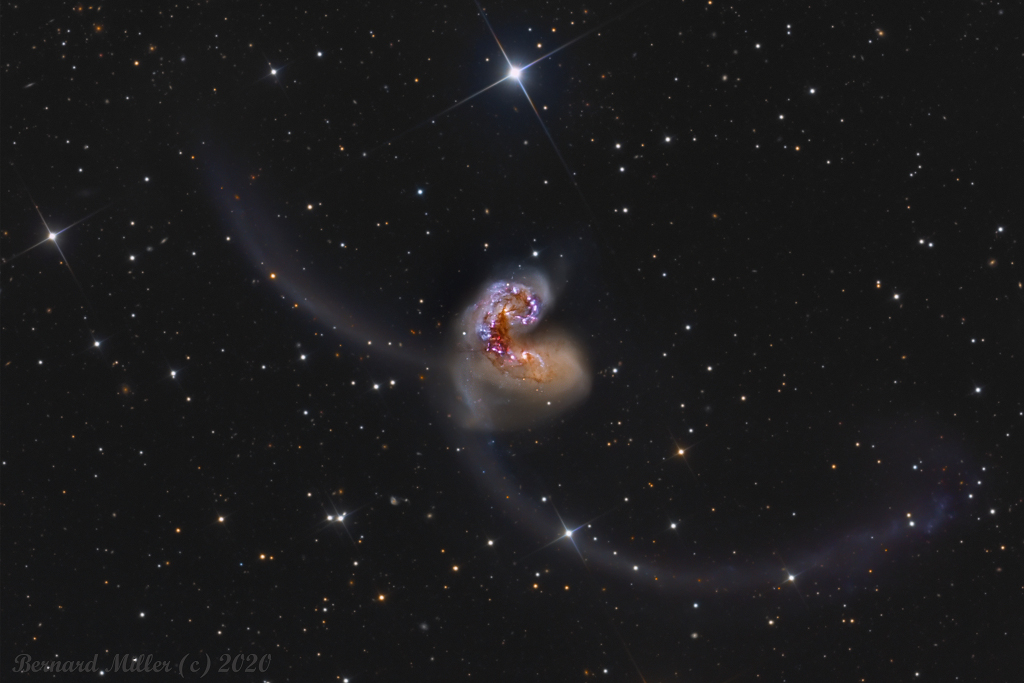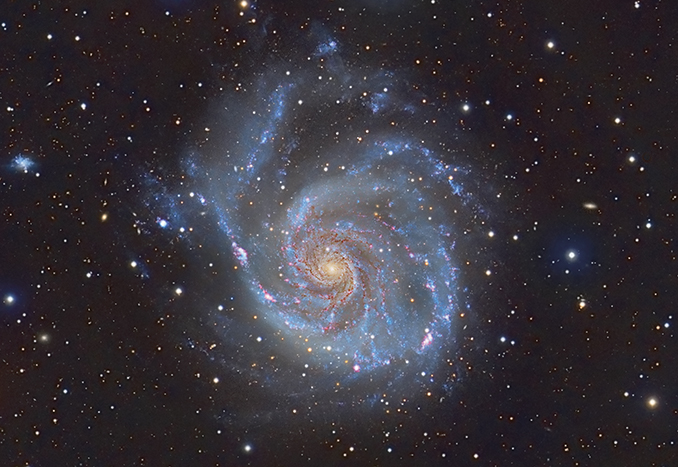Page 1 of 1
APOD: Arp 93: A Cosmic Embrace (2023 Aug 16)
Posted: Wed Aug 16, 2023 4:06 am
by APOD Robot
 Arp 93: A Cosmic Embrace
Explanation: Locked in a cosmic embrace
Arp 93: A Cosmic Embrace
Explanation: Locked in a cosmic embrace, two large galaxies are merging at the center of this sharp telescopic field of view. The interacting system cataloged
as Arp 93 is some 200 million light-years distant toward the constellation Aquarius in planet Earth's sky. Individually the galaxies are identified as NGC 7285 (right) and NGC 7284. Their bright cores are still separated by about 20,000 light-years or so, but a massive
tidal stream, a result of their ongoing gravitational interaction, extends over 200,000 light-years toward the bottom of the frame. Interacting galaxies do look
peculiar, but are now understood to be common in the Universe. In fact, closer to home, the large spiral Andromeda Galaxy is known to be approaching the Milky Way. Arp 93 may well present an analog of their distant
future cosmic embrace.
Re: APOD: Arp 93: A Cosmic Embrace (2023 Aug 16)
Posted: Wed Aug 16, 2023 5:22 am
by Ann
Oh wow, I wish I didn't feel compelled to write about this APOD, because I have no time! But I can't resist it!
Let's look at the main attraction of today's APOD, and also sneak a peek at an interesting sideshow:
Main attraction: Arp 93: A Cosmic Embrace
Image Credit & Copyright: Mike Selby, Observatorio El Sauce
Sideshow: See the four-armed barred ring galaxy
and its playmates, ladies and gents!
Anyway. Today's APOD is a great image, and I love the fact that it is highlighting a colliding pair of galaxies that I had never seen a picture of before. Arp 93 is an interesting creature too, as it appears to be a collision between a barred spiral galaxy with dust and gas, and an elliptical galaxy seemingly devoid of anything but old yellow stars.
According to my software, NGC 7285 is the spiral galaxy, and NGC 7284 is the all-yellow elliptical galaxy. It does look as if NGC 7284 is embracing NGC 7285 with its soft all-yellow arms!
Well, I have used up my three attachments now, so I'll have to make a new post if I want to make any more comparisons. And I do.
Ann
Re: APOD: Arp 93: A Cosmic Embrace (2023 Aug 16)
Posted: Wed Aug 16, 2023 6:07 am
by Ann
The fact that Arp 93 appears to be a merger between a galaxy containing (not that much) gas and one completely devoid of it gives it certain characteristics. Let's first compare a collision between two galaxy completely lacking gas and dust with the gas-rich Antennae galaxies merger:
A "dry" merger between IC 1181 and IC 1178.
Credit: Detlef Hartmann.
As you can see, there are no dust lanes and no obvious clusters of any kind in the merger between IC 1181 and IC 1178. The bright clumps that seem to be located in the tidal tails of these galaxies are most likely background galaxies, although I have to admit that at least in the case of IC 1178, the bright clumps seem to outline a part of a ring around the galaxy's core and then dot the outline of its tidal tail. Nevertheless, the scarcity of gas and dust in these galaxies makes their merger a "dry" one.
In the case of the Antennae Galaxies, it is NGC 4038, at top in the image I posted, that is the truly gas-rich one. All the gas in NGC 4038 has led to a magnificent starburst in the disk of this galaxy. Actually I think that the most pink-bursting arc-shaped thing in NGC 4038 is actually a spiral arm that has been bent over backwards because of the tidal forces of the collision.
In Arp 93, there appears to be no star formation or even young stars at all in the disks of any of the two colliding galaxies. But gas has been driven out of NGC 7285 into a fantastically long and wide tidal feature, which does indeed contain some young blue stars. But the bluest part of NGC 7285 is one of its spiral arms.
Let's compare the overall appearance of Arp 93 with the overall appearance of the Antennae Galaxies, tails and all:
Arp 93: A Cosmic Embrace
Image Credit & Copyright: Mike Selby
It would seem that a lot more gas has been driven out of NGC 7285 than has been driven out of the Antennae Galaxies. The "My Favorite Martian" galaxies display two long and narrow tails, whereas NGC 7285 looks like it is emptying a bucket of liquids into space. Or, almost at least, as if someone is throwing boiling hot water into way-below freezing temperature air:
Edit: Come to thin of it, boiling water being thrown into far-below freezing temperatures and instantly turning into a cloud of ice crystals is not a good comparison with what is happening in the tidal tail of NGC 7285, because liquid water turning to ice is a "phase change", I think it's called, whereas the gas in NGC 7285 is merely being "thrown out". So the bucket simile it is. But I'm keeping the other picture too because it looks cool!

Edit 2: Come to think of it 2, IC 1181 and IC 1178 in the first picture I posted here are emptying buckets, too. Buckets of stars.
Buckets of stars like grains of sand.
Ann
Re: APOD: Arp 93: A Cosmic Embrace (2023 Aug 16)
Posted: Wed Aug 16, 2023 6:54 pm
by ems57fcva
I see no signs of a interacting connection between NGC 7284 and NGC 7285. My opinion is that NGC 7285 is a smaller galaxy in the same cluster that is in front of NGC 7284 and which has not yet started to interact with NGC 7284. I believe that NGC 7284 is at least 0.5 million LY from NGC 7285 and suspect that the actual distance between these galaxies is 2+ million LY.
Even so, NGC 2784 has definitely been subject to recent tidal disruption by another, smaller galaxy. I suspect that the real disruptor is behind NGC 7284, as I see not sign of a star bridge connecting any of the other small galaxies in that image to NG 2784.
Re: APOD: Arp 93: A Cosmic Embrace (2023 Aug 16)
Posted: Wed Aug 16, 2023 7:21 pm
by ems57fcva
On second thought, as I look more at that photo, it occurs to me that NGC 7284 has two yellow spiral arms originating from opposite ends to the bar at its core. The arm starting from the 2:30 position wraps around and goes behind NGC 7285. The bar starting at the 8:30 position has more gas and dust, and ends up going just outside of the first arm. Then starting at the 1:00 position and branching off of the second spiral arm is a "arm" of blue stars wraps around NGC 7284 and ends at a yellow cluster at the 4:30 position (from the core of NGC 7284). I believe that this cluster is the remains of the core of the disrupting galaxy: It appears at the end of what could be a bridge of new stars.
Surrounding the bridge is a halo of gas and stars which were thrown out by the tidal disruption of NGC 7284 by the disruptor. Much of the tidal debris is in a fan in the area of the 6:00 to 8:00 positions. I suspect that this is from the time when the disruptor penetrated the spiral ring of NGC 7284. Note that the disruptor was a small galaxy that itself was largly disrupted and its stars scattered by this collision. The yellow cluster at the 4:30 position is all that remains of it, or rather its core.
Re: APOD: Arp 93: A Cosmic Embrace (2023 Aug 16)
Posted: Wed Aug 16, 2023 8:31 pm
by johnnydeep
ems57fcva wrote: ↑Wed Aug 16, 2023 6:54 pm
I see no signs of a interacting connection between NGC 7284 and NGC 7285. My opinion is that NGC 7285 is a smaller galaxy in the same cluster that is in front of NGC 7284 and which has not yet started to interact with NGC 7284. I believe that NGC 7284 is at least 0.5 million LY from NGC 7285 and suspect that the actual distance between these galaxies is 2+ million LY.
Even so, NGC 2784 has definitely been subject to recent tidal disruption by another, smaller galaxy. I suspect that the real disruptor is behind NGC 7284, as I see not sign of a star bridge connecting any of the other small galaxies in that image to NG 2784.
I think you are misinterpreting the image, or else I am misinterpreting what you mean. The two galaxies are clearly interacting and their cores are very close. Here's an annotated image from
https://www.hansonastronomy.com/ngc-7285 (note that NGC 7285 is on the LEFT, and not the right as the APOD text states):
[ EDIT: ok, I do see now what you were saying: that NGC 7284 could perhaps be an elliptical in front of the spiral arms of NGC 7285. But I'm sure there must be some "proof" or at least some strong evidence, that they are actually interacting that's not stated here? ]
Re: APOD: Arp 93: A Cosmic Embrace (2023 Aug 16)
Posted: Wed Aug 16, 2023 8:33 pm
by orin stepanek
When MW & Andy collide there will be no place to hide; so just sit
back and enjoy the show! Oh that's right we would not be around
anymore!

Re: APOD: Arp 93: A Cosmic Embrace (2023 Aug 16)
Posted: Wed Aug 16, 2023 10:32 pm
by Roy
Noteworthy is that the image was obtained from Observatorio El Sauce, in the Atacama desert Peru, where you can send your own telescope. Or you can rent time on one of their 100 instruments, using an outfit (service?) called Chilescope. The observatory link proved very interesting.
Re: APOD: Arp 93: A Cosmic Embrace (2023 Aug 16)
Posted: Thu Aug 17, 2023 2:58 am
by Avalon
Amazing image, especially with the cores remaining still so intact as the galaxies interact.
What also caught my eye was the little gem of a galaxy in the upper left corner that somewhat resembles a wheel with spokes and has lots of star forming action going on. Any comments?
Re: APOD: Arp 93: A Cosmic Embrace (2023 Aug 16)
Posted: Thu Aug 17, 2023 4:24 am
by Ann
ems57fcva wrote: ↑Wed Aug 16, 2023 6:54 pm
I see no signs of a interacting connection between NGC 7284 and NGC 7285. My opinion is that NGC 7285 is a smaller galaxy in the same cluster that is in front of NGC 7284 and which has not yet started to interact with NGC 7284. I believe that NGC 7284 is at least 0.5 million LY from NGC 7285 and suspect that the actual distance between these galaxies is 2+ million LY.
Even so, NGC 2784 has definitely been subject to recent tidal disruption by another, smaller galaxy. I suspect that the real disruptor is behind NGC 7284, as I see not sign of a star bridge connecting any of the other small galaxies in that image to NG 2784.
Remember Occam's razor?
Wikipedia wrote:
This philosophical razor advocates that when presented with competing hypotheses about the same prediction, one should prefer the one that requires the fewest assumptions
Let's see. The prediction, when it comes to Arp 93, is that the long tidal tail of NGC 7285 was caused by this galaxy's interaction with another galaxy. The competing hypotheses have to do with identifying the galaxy that caused the tidal disturbance of NGC 7285.
The first hypothesis is this one:
1) We can see that NGC 7285 appears to be located very, very close to NGC 7284. Their cores appear to be extremely close to one another. And we know from other interacting and merging galaxies that this kind of interaction can cause long tidal tails.
And because NGC 7284 is the only galaxy that we can see close to NGC 7285, we believe that NGC 7284 must be interacting with NGC 7285 to cause the long tidal tail of NGC 7285.
The second hypothesis in this one:
2) We can see that NGC 7285 appears to be located very, very close to NGC 7284. Their cores appear to be extremely close to one another. And we know from other interacting and merging galaxies that this kind of interaction can cause long tidal tails. NGC 7284 is the only galaxy that we can see close to NGC 7285.
However! We are not satisfied that NGC 7284 has caused the tidal disturbance of NGC 7285. We are unhappy with the appearance of the so-called interaction. We think that NGC 7285 and NGC 7284 ought to look different than they do, if they were interacting.
Therefore, we believe that NGC 7285 and NGC 7284 are not interacting.
We believe that NGC 7284 must be located in front of NGC 7285, at least 0.5 million light-years in front of it, and most likely more than 2 million light-years in front of it.
We believe that a third galaxy must be involved. We believe that this galaxy must have collided or interacted with NGC 7285.
We can't see this galaxy, but we believe in its existence, because we can't accept that NGC 7284 is interacting with NGC 7285.
So, conclusion. The hypothesis that NGC 7284 is interacting with NGC 7285 is the one that requires the smallest number of assumptions.
The hypothesis that a third galaxy must be the one that interacted with NGC 7285 is not likely to be accepted by the astronomical community unless this putative third galaxy can be identified and its interaction with NGC 7285 can be made plausible.
The argument that the interaction between NGC 7285 and NGC 7284 "looks wrong" and therefore can't be happening is not likely to impress a large chunk of the astronomical community. Astronomers know that
interactions between galaxies can look very different indeed.
Ann
Re: APOD: Arp 93: A Cosmic Embrace (2023 Aug 16)
Posted: Thu Aug 17, 2023 8:33 am
by Ann
Avalon wrote: ↑Thu Aug 17, 2023 2:58 am
Amazing image, especially with the cores remaining still so intact as the galaxies interact.
What also caught my eye was the little gem of a galaxy in the upper left corner that somewhat resembles a wheel with spokes and has lots of star forming action going on. Any comments?
Background galaxy behind NGC 7284/7285. Credit: Mike Selby
It reminds me of M101.

Ann
Re: APOD: Arp 93: A Cosmic Embrace (2023 Aug 16)
Posted: Thu Aug 17, 2023 12:45 pm
by johnnydeep
Ann wrote: ↑Wed Aug 16, 2023 5:22 am
Oh wow, I wish I didn't feel compelled to write about this APOD, because I have no time! But I can't resist it!
Let's look at the main attraction of today's APOD, and also sneak a peek at an interesting sideshow:
APOD 16 August 2023 detail.png
Main attraction: Arp 93: A Cosmic Embrace
Image Credit & Copyright: Mike Selby, Observatorio El Sauce
Background galaxies APOD August 16 2023.png
Sideshow: See the four-armed barred ring galaxy
and its playmates, ladies and gents!
Anyway. Today's APOD is a great image, and I love the fact that it is highlighting a colliding pair of galaxies that I had never seen a picture of before. Arp 93 is an interesting creature too, as it appears to be a collision between a barred spiral galaxy with dust and gas, and an elliptical galaxy seemingly devoid of anything but old yellow stars.
According to my software, NGC 7285 is the spiral galaxy, and NGC 7284 is the all-yellow elliptical galaxy. It does look as if NGC 7284 is embracing NGC 7285 with its soft all-yellow arms!
Cosmic embrace APOD August 16 2023.png
Well, I have used up my three attachments now, so I'll have to make a new post if I want to make any more comparisons. And I do.
Ann
The astrobin link revealed that your "four-armed barred ring galaxy" is PGC 786141, but I can't find anything more about it.
 Arp 93: A Cosmic Embrace
Arp 93: A Cosmic Embrace





